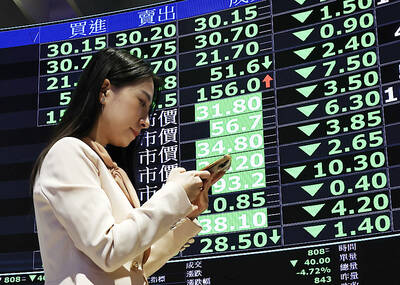The Taiwan High Speed Rail Corp (THSRC, 台灣高鐵) has performed well, if not better than many international enterprises, if taxes, interest payments and depreciation costs are taken into account, the Ministry of Transportation and Communications (MOTC) said in a report yesterday.
The assessment was made based on the earnings before interest, taxes, depreciation and amortization (EBITDA) indicator, one of the most universal and comparable performance indicators, which reflects the actual earning potential of a company.
The company’s EBITDA margin reached 56.1 percent last year. That was higher than Hong Kong MTR Corp’s 52.9 percent, the Central Japan Railway Co’s 40.8 percent, Singapore MRT Ltd’s 34 percent, East Japan Railway Co’s 28 percent and West Japan Railway Co’s 20.4 percent.
THSRC’s earnings, after taxes, interest, deprecation and amortization, however, reached a negative 59.6 percent.
Attributing THSRC’s lackluster operating performance to its unreasonable financing structure, the ministry report said that beginning last year, the company’s monthly revenues totaled about NT$2 billion (US$62 mllion), but after deducting operating outlays, the revenues were not enough to make interest and depreciation payments.
The NT$500 billion high-speed line was 80 percent funded through bank debt, leaving a legacy of huge interest payments.
THSRC’s annual report last year said the company’s business turnover was NT$23.05 billion last year, a significant 70.7 percent growth over the previous year. But the company also reported interest payments of NT$17.4 billion and depreciation charges of NT$18.9 billion, which led to an accumulated loss after taxes of NT$25.01 billion.
If the company wants to become profitable, it should seek a reasonable resolution to its interest and depreciation problems, aside from tapping new sources of revenue and cutting expenditure, the ministry said.
In related developments, Susan Chang (張秀蓮), chairwoman of the state-run Taiwan Financial Holding Co (台灣金控) and Bank of Taiwan (台灣銀行), said yesterday that the syndicated loan lenders have lowered the interest rate for the company’s NT$308.3 billion in first-round syndicated loan to 2.6 percent.
If there was still room for further cuts, it would probably be within 1 percentage point, and would be expected to begin from next month, she said.
Meanwhile, Chinese Nationalist Party (KMT) Legislator Chen Chieh (陳杰) said THSRC’s five major shareholders should serve as guarantors when the second-round syndicated loan involving NT$65.5 billion is granted.
Another concern is the extraordinarily high salaries THSRC top executives receive, even though the company has been in the red.
Last year’s annual reports said each of the 22 vice presidents were paid more than NT$2 million per year, while each of its three foreign consultants earns NT$10 million a year.
THSRC spokesman Ted Chia (賈先德) said the three foreign executives were professionals that many international firms have been scrambling to recruit.
Chia said there was still a lot of work since the high speed rail became operational, including training and development of drivers and other staff, equipment maintenance, marketing, engineering, and the three have been very helpful in the company’s operations.

TARIFFS: The global ‘panic atmosphere remains strong,’ and foreign investors have continued to sell their holdings since the start of the year, the Ministry of Finance said The government yesterday authorized the activation of its NT$500 billion (US$15.15 billion) National Stabilization Fund (NSF) to prop up the local stock market after two days of sharp falls in reaction to US President Donald Trump’s new import tariffs. The Ministry of Finance said in a statement after the market close that the steering committee of the fund had been given the go-ahead to intervene in the market to bolster Taiwanese shares in a time of crisis. The fund has been authorized to use its assets “to carry out market stabilization tasks as appropriate to maintain the stability of Taiwan’s

STEEP DECLINE: Yesterday’s drop was the third-steepest in its history, the steepest being Monday’s drop in the wake of the tariff announcement on Wednesday last week Taiwanese stocks continued their heavy sell-off yesterday, as concerns over US tariffs and unwinding of leveraged bets weighed on the market. The benchmark TAIEX plunged 1,068.19 points, or 5.79 percent, to 17,391.76, notching the biggest drop among Asian peers as it hit a 15-month low. The decline came even after the government on late Tuesday authorized the NT$500 billion (US$15.2 billion) National Stabilization Fund (國安基金) to step in to buoy the market amid investors’ worries over tariffs imposed by US President Donald Trump. Yesterday’s decline was the third-steepest in its history, trailing only the declines of 2,065.87 points on Monday and

TARIFF CONCERNS: The chipmaker cited global uncertainty from US tariffs and a weakening economic outlook, but said its Singapore expansion remains on track Vanguard International Semiconductor Corp (世界先進), a foundry service provider specializing in producing power management and display driver chips, yesterday withdrew its full-year revenue projection of moderate growth for this year, as escalating US tariff tensions raised uncertainty and concern about a potential economic recession. The Hsinchu-based chipmaker in February said revenues this year would grow mildly from last year based on improving supply chain inventory levels and market demand. At the time, it also anticipated gradual quarter revenue growth. However, the US’ sweeping tariff policy has upended the industry’s supply chains and weakened economic prospects for the world economy, it said. “Now

An employment discrimination lawsuit against contract chipmaker Taiwan Semiconductor Manufacturing Co (TSMC, 台積電) might soon be expanded after a hearing in a federal court in San Jose, California, on Tuesday to add 15 plaintiffs to the case. According to a court document, the lawsuit, which was refiled in November last year as a form of a class action with 13 plaintiffs in California, wants to add 15 plaintiffs from Arizona, where TSMC is building up its wafer fab capacity. TSMC first committed between 2020 and last year to invest US$65 billion in three advanced wafer fabs in Arizona. It then pledged an